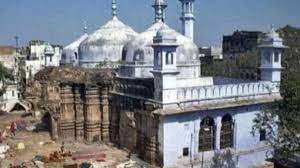January 27, 2024
The Controversial History of Gyanvapi Mosque: Aurangzeb’s Decree and its Consequences
Introduction:
• The recent findings by the Archaeological Survey of India (ASI) have reignited the debate surrounding the Gyanvapi mosque in Varanasi. The ASI’s assertion that a substantial Hindu temple existed before the mosque raises questions about historical events, particularly the role of Emperor Aurangzeb in its destruction.
Aurangzeb’s Decree and Temple Destruction:
• Historical records, including Saqi Mustaid Khan’s Maasir-i-Alamgiri, shed light on Aurangzeb’s 1669 farmaan, a royal decree aimed at the demolition of temples and schools of non-Muslims. Jadunath Sarkar’s translation of the text emphasizes Aurangzeb’s zeal to establish Islam, citing the destruction of the Vishwanath temple in Kashi and the Keshavdev temple in Mathura. This is seen as part of a larger strategy targeting Hinduism.
Political Motives Behind Temple Demolition:
• Historians such as S A A Rizvi and Richard Eaton provide insights into Aurangzeb’s changing policies, suggesting a departure from Akbar’s era of coexistence. Eaton argues that the 1669 farmaan targeted institutions where certain teachings were taking place, especially in Benares. There are theories linking the destruction of the Kashi temple to Chhatrapati Shivaji’s escape, presenting it as a form of retribution.
Aurangzeb’s Perspective:
• Aurangzeb viewed temples as potential centers for spreading subversive ideas, according to Satish Chandra. This perspective justified, in his eyes, the destruction of even long-standing Hindu temples as a means of punishment and warning, particularly in conflicts with local elements.
Gyanvapi Mosque and its Ambiguous Origins:
• The Gyanvapi mosque likely emerged in the 1670s or ’80s on the ruins of the destroyed temple. Unlike the Shahi Eidgah built over the Mathura temple, the patron of the Gyanvapi mosque remains unknown. The mosque incorporates a part of the ruined temple’s wall, possibly as a symbolic statement about the consequences of opposing Mughal authority.
Conclusion:
• The ASI’s findings and historical accounts illuminate a complex chapter in Indian history, marked by Aurangzeb’s decree and the subsequent destruction of Hindu temples. The Gyanvapi mosque, standing on the remnants of a once-grand temple, adds layers to the historical narrative, prompting a reconsideration of Aurangzeb’s policies and their lasting impact on religious structures in the region.
January 30, 2025
January 20, 2025
January 14, 2025

